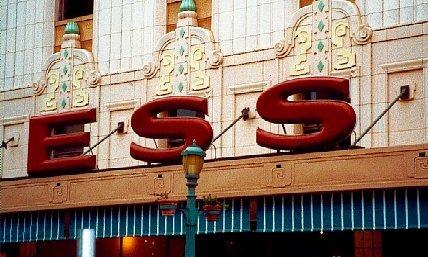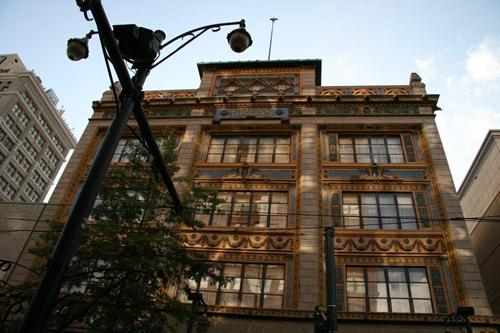|
|
Samuel
Henry Kress was born in Cherryville, Pennsylvania in July of 1863.
His father worked as a supervisor at a coal mine and Sam was one of
seven children.
Young Mr. Kress tried his hand at teaching before opening a stationery
business in Nanticoke, Pa. in 1887. As his store prospered, he reinvested
his profits and opened more stores, incorporating as S. H. Kress &
Co. He never married or had children. His first large-scale store
was said to be in Memphis, Tennessee. |
Detail of the
former Kress Building in Memphis, Tennessee.
Photo courtesy Stephen
Michaels, July 2007 |
|
In 1878 Frank
Winfield Woolworth opened his first 5 and 10 cent store and his
rapid success was no doubt noticed by Sam Kress. While Kress may
have “borrowed” the concept of a “five-and-dime” from Frank Woolworth,
when Woolworth died, Kress acknowledged his mentor by closing his
stores for the funeral and giving his employees the day off. A most
un-businesslike decision for those times.
A lifelong bachelor, Kress spent his leisure collecting European
art. Instead of amassing a large single collection, and donating
it as such, he donated over 3,000 paintings, statues, sculptures,
furniture and tapestries to museums across America. In 1945 he became
president of the National Gallery of Art.
1929 was a bad year for many. But it was a milestone for Kress.
The Kress Foundation (for the appreciation of European art) was
organized and that same year Sam Kress hired Brooklyn-born Architect
Edward F. Sibbert, Jr. Sibbert soon became Kress’ chief architect
and for the next 25 years, designed over 50 Kress stores – most
of them prestigious locations in major cities. Art Deco or Zig-Zag
designs were favored and Sibbert-designed stores are considered
prizes in the world of Kress buildings. Edward Sibbert died in 1982,
surviving his boss by some twenty-seven years.
Samuel H. Kress died in New York City, in a penthouse atop one of
his properties in September of 1955, aged 92.
With no wife and no heirs, Sam Kress’ company was sold in 1964 –
just about the time malls started appearing and populations started
leaving cities for Suburban Utopia. The company that acquired the
Kress holdings liquidated its assets in 1980.
In
Texas, Kress operated stores in at
least fourteen cities, including Amarillo,
Brownsville,
Corpus
Christi, Dallas, Del
Rio, El
Paso, Fort Worth,
Greenville, Houston,
Laredo,
Lubbock,
Port Arthur,
San Antonio and Texarkana.
|
 |
Detail of San
Antonio's former Kress Building
TE Photo, April 2001 |
Some buildings
aren't as grand as others.
A 70s look in downtown Brownsville
Photo Courtesy Ken
Rudine, 2007 |
Florida
had nine stores including Jacksonville, Key West, Miami, Orlando,
St. Petersburg, and Tampa. California had stores in Bakersfield, Berkeley,
Hollywood, Inglewood, Long Beach, Modesto, Los Angeles, Sacramento,
San Pedro, Santa Rosa, and Stockton, and the other Kress stores were
spread across the U. S. extending even to the (then) territories of
Hawaii (Hilo and Honolulu) and Puerto Rico.
During the Great Depression, low labor costs and cheap construction
material gave Kress an opportunity to expand. Most Kress stores were
simple two to four story buildings but were much larger in larger
cities such as New Orleans, Los Angeles and Miami.
Costs
were usually between $50K to $100K for steel frame, concrete and brick
veneer (with terra cotta detail) buildings. Buildings often included
extras like basements and mezzanines – but were always constructed
with the best materials available. Floor joists were 16 inches square
and staircases were marble. Fire escapes were custom-ordered wrought
iron and, of course, the Kress name was almost always gilded.
The company didn’t hesitate to expand, rebuild, remodel or demolish
and start from scratch. The magnificent Memphis store, which is currently
in use as a Marriott Springhill Suites, is in its fourth incarnation.
|
 |
|
The Memphis
former Kress Store in late Afternoon
Now owned by Marriott Hotels
Photo courtesy Stephen
Michaels, July 2007
|
One
source lists about 100 surviving Kress buildings in America. Locating
stores next to post offices, city halls and other public buildings
was not coincidental but carefully planned. Their location made them
integral parts of many downtowns and the quality of construction (as
well as their beauty) insured their longevity. The ratio of survival
for Kress buildings is somewhat higher than railroad
depots and on a par with Carnegie
libraries.
The number of stores Kress had at its zenith is in dispute. Some sources
give 300 stores in 30 states while others cite a total of 400 stores.
Many stores have been added to the National Register of Historic Places
and many of those who are not on the Register have at least been declared
local landmarks or are otherwise protected. |
A stately and
elegant Kress Building in Selma, Alabama
Photo courtesy Stephen
Michaels, February 2008 |
|
The
former Kress store in Long Beach, California is being converted
into lofts and across the country, reuse of the stores seems to
be going in the direction of condos, lofts or hotels. In smaller
towns like Iola, Kansas, stores have short-term tenants. At least
one former building is a biker bar (Port Arthur, Texas). Many stores
remain vacant and some are for sale. Considering the materials of
even the most modest of stores, they are a bargain.
|
A forlorn Kress
in Iola, Kansas
TE Photo March, 2005 |
Port
Arthur Kress Building Detail
TE
Photo, May 2003 |
|
Kress Detail
in Ardmore, Oklahoma
TE Photo, June 2004
|
Ponca City,
Oklahoma Detail
TE Photo February 2005 |
A Main Street
Anchor in Chanute, Kansas
TE Photo May 2005 |
|
The San
Antonio Kress Building in 2001
(Undergoing restoration in 2008)
|
Kress Building
in El Paso, Texas
Postcard courtesy www.rootsweb.com/ %7Etxpstcrd/ |
The
Building Museum in Washington D.C. showcased the Kress Buildings in
a 1997 exhibit called Main Street Five-and-Dimes: The Architectural
Heritage of S.H. Kress & Co. The museum is a repository for 13,000
drawings, blueprints and photographs from the former Kress archives.
By employing exotic motifs, distinctive details and quality materials,
Kress architects put their stores on the same level of banks,
post offices
and libraries. Designs were tasteful and patrons felt up-lifted from
their hum-drum existence. Kind of like the present-day Wal-Mart experience.
>
© John Troesser
First published March 2008 |
|
|
